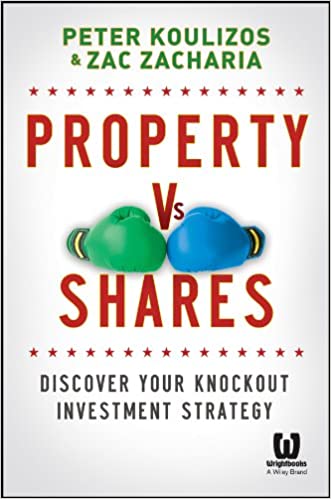Book Review – Property vs Shares by Peter Koulizos and Zac Zacharia

This seems to be an age-old debate within the finance community. I have noticed that the majority of people within the FIRE community tend to have a preference for shares, and the general investor seems to lean towards property. This is only from my own anecdotal observations; my own perceptions could very well be incorrect.
A lot of investment books will talk about shares and property, but this is the first time I have seen a book which provides a direct comparison on the different elements associated with property and share investment. I really appreciated the detail this book went into on each facet of investing.
At the start of the book, it was quite basic, and I was a little bit disappointed and was hoping for a bit more. I knew it was for beginner investors, but I still had higher expectations. Luckily, I was premature in my opinion and it did not take long for the book to start to provide the in-depth information I was looking for.
The book goes through 20 or so different “Rounds” (yeah it sort of is like a boxing match) to compare Property vs Shares in a wide-ranging number of categories. For example, they compare, volatility, degree of control, leverage, liquidity etc. Overall, it makes for a comprehensive breakdown and a thorough comparison of Property and Shares.
One drawback of the book was it is somewhat outdated, but this happens quickly in the world of finance where changes happen quickly. The book was written in 2013, and at the time it was recovering from the GFC, and a lot has happened in the last 8 years. So, although the vast majority of the book is still relevant, there are some points which may not be quite as relevant (talking about mortgage interest rates of 5.00% per annum for instance).
Overall, I have found that when people are generally starting out to invest in Australia, there seems to be an automatic focus that property is the way to go. I really appreciate that there is a book available for relatively beginners to the investing world that can go through a side-by-side comparison of property and shares and where each asset class has advantages and disadvantages. This way someone new to investing can make an informed decision about where they choose to invest their money.
I will say, that even if someone has experience in investing, then I can assure you that you will almost definitely learn something from this book that you did not know about earlier. Personally, I learnt a lot about the impacts of different trust structures will have on investments. It was really useful to see a side-by-side comparison of how different structures have their own advantages and disadvantages.
One thing in particular I was not the biggest fan of was this example they used as an example for the benefits of leverage.
“If you had $40,000 in cash, you could buy a $400,000 property. Half of your cash will go towards the deposit for the house and the other half towards purchasing fees. Alternatively, if you had $40,000 in cash, you could buy a portfolio of blue-chip shares valued at $160,000. If we assume both assets will grow at about their long-term average, it would take more than 100 years for a $160,000 share portfolio growing at 10% per year to be worth more than a $400,000 property growing at 9% per year!”
So, while mathematically, the above may be true, I do believe it is a bit disingenuous to assume that property prices will continue to rise at 9.00% per annum for a significantly long period of time. Even assuming 10% per annum growth of shares is a bit too optimistic for my own personal numbers as well.
In the above example, the $400,000 property would be worth over $2,000,000 in just under 20 years. That to me just seems a bit unrealistic, even taking inflation into account. I realise the point they are trying to make however, that leverage can be very powerful in magnifying returns, I just think the example was a bit too extreme.
In summary, I was pleasantly surprised with the thoroughness of this book, I thought the cover was a bit gimmicky, and the premise of it being a boxing match gave me the impression it wouldn’t be too serious. The actual content, however, was highly informative and helpful and there were several things I did learn throughout the book. I admit that not all of it was relevant or useful, but I am sure to some people it could indeed be especially useful in helping them with their investment decisions in the future.